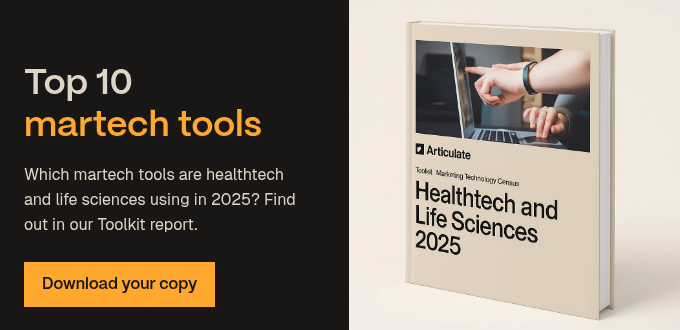Fun fact. The majority of HealthTechs found that, after increasing the marketing budget, their return on investment grew by 10 or more percent. So says this 2021 McKinsey survey.
They got more back than they put in, in other words.
If that’s not reason to invest in your marketing, then what is? We suggest focusing on content marketing if you want to to establish yourself as a thought leader in the health sector. Our team of experienced B2B tech marketers came up with these nine tips for how to write about health technology. Use them for your next campaign (or, heck, ask us to write it for you).
1. Keep your tone energetic and optimistic
Your company is doing incredible work, offering solutions and tools that could revolutionise healthcare. You’re also giving people access to information that genuinely saves lives. This is amazing — really. Your tone of voice should be on the level of that significant mission.
2. Remember the human perspective
Your focus is on interventions, medicines and technologies. This makes sense; that’s what you’re offering.
However, it’s vital to maintain the human angle throughout. In the end, it all comes back to the people affected by certain conditions. The knowledge you can provide gives those people the chance to make plans and feel more in control of their healthcare. Your advice, or the signposting you provide to vital information, may even lead to early diagnosis.
3. Address your personas, in their language
Health technology has a range of possible audiences. Medical insurers or doctors, for example. These people are extremely knowledgeable in their field. So, ensure you use terminology in a way that is familiar to and appropriate for that audience. Respect their expertise and avoid talking down to them.
Another big audience is those living with a medical condition. While they may not use the same terminology, take a similar approach in respecting their expertise. They know the most about their own experiences, guaranteed.
4. Be mindful of sensitive or serious topics
We’ve touched on writing about technology before, which is something we do a lot at Articulate. The key is to tap into the aforementioned human perspective — to appeal to the emotions, goals and pain points of your audience. Marketing B2B tech companies requires an extra effort to tap into those buying motivators, because the default is to talk about technological features.
HealthTech is a little different. Often, your content will touch on sensitive subjects, such as safeguarding, menopause or end-of-life care. These are already emotionally charged topics. The best approach here is to write empathetically but be factual and clear.
Demonstrate understanding. Contextualise the topic in a wider setting so the reader does not feel alone with their concerns. Be encouraging. And above all, do not go for the hard sell. Your job is to help the reader make the best decisions, armed with as much information as possible.
5. Be cautious of your word choices
We’ve had a few learning moments around word choice in our own writing for HealthTech clients. Phrasing matters. Nuance matters.
Here are a few words and phrases to avoid:
- ‘Suffers from’/’sufferer’/’afflicted by’ — Particularly when used in the context of disability, you would be better to use something like ‘lives with’.
- ‘Victim of’ — Similarly, use something like ‘has…’ or ‘has experienced…’ instead.
- ‘Committed [act]’ — Whatever the act may be, self-harm or suicide, putting the onus or agency on the person leads to stigma. The person is not the one to blame; their condition has caused these symptoms or outcomes.
When editing your content, use this style guide from The National Centre on Disability and Journalism to check your word choices.
6. Always use inclusive language
Inclusive language is vital in a healthcare context, but it can be a minefield.
Certain groups prefer person-first language, for example. Others, such as many autistic self-advocates (I say this as an autist myself), prefer identity-first language. This is a hotly debated topic. As we’ve said, terms change with the times. Do your research on a case-by-case basis in these circumstances.
Otherwise, there are a few best practices you can follow. For example, use gender neutral pronouns or terms such as ‘people who are pregnant’ rather than ‘women who are pregnant’. In so doing, you avoid excluding those who might benefit from what you have to say.
7. Keep up to date with accepted terms
In the UK, we have come to use ‘service user’ for those who make use of care services. And ‘service provider’ for the provider of these services. These are the accepted terms in the industry, and with good reason. They are factual. They indicate no assumptions about the service user’s capabilities, and so they avoid bias. However, vitally, this is by no means a settled subject. It may evolve.
Accepted terms change over time. What was once acceptable may no longer be. As we have open discussions, and as more voices are heard, these things change. As writers, we must check our assumptions at the door and not simply write what we think is okay. And as health technology businesses, you need to be prepared to review published content and update it when accepted terms change over time.
8. Use authoritative and verified sources
Misinformation is rife in the health sector. Four out of five health tech providers publish incorrect information every month. We made that statistic up, but truthfully, this is a big problem. For example, a study held in early 2022 found that between 45 and 55 percent of surveyed consumers worldwide had witnessed false or misleading COVID-19 news in the preceding week.
It’s your job to ensure you’re using authoritative and verified sources. Make sure any statistics that you refer to are within an acceptable date range, such as from within the last two years. Link to the original source whenever possible, rather than articles of aggregated statistics. Check the authorship of your quotes. Use trusted sources, like McKinsey or the NHS website.
9. Avoid common writing pitfalls
- Jargon — We see this across the B2B tech landscape and HealthTech is no exception. While you may be right to use certain esoteric terms, given the audience, try to avoid unnecessary acronyms or jargon as much as possible. It doesn’t make you sound clever and it is more likely to be confusing for the reader.
- Hyperbole — ‘State of the art’, ‘best in class’ and ‘world-leading’ are phrases we could live without seeing again. Hype simply highlights what’s missing: facts, accreditations, tangible benefits, data. You’re not fooling anyone. Get rid.
- Fearmongering — You want to put the reader at ease. Yes, you may be addressing hard truths and righting big wrongs, but don’t leave your audience paralysed with fear. Instead, provide actionable steps that contribute to the cause or resolve problems. Research shows that having a sense of agency and ownership greatly reduces the impact on those who have experienced trauma, and contributes towards PTSD recovery. Based on these principles, when writing about worrisome subjects, give your readers positive actions that they can take away and do.
- Sugar-coating — On the other end of the scale is sugar-coating. In trying to avoid fearmongering, you can end up in a land of euphemisms and half-truths. This makes for unclear messaging and can invite backlash if you’re seen to be underplaying the severity of a certain sensitive subject. Be transparent; be factual.
Thank you, marketing team
Thank you to the writers of Articulate’s in-house Studio, Claire Rowe, Clare Dodd, Rachel Kennedy and Adam Catterall, who contributed their advice to this article. All these best practices are based on our collective experience writing for HealthTech clients, including the largest telehealth provider in Europe. (<< That link takes you to our award-winning case study, dontchaknow.)
If you’re considering agency support for your HealthTech business — whether that’s copywriting, a new website or a strategic nudge in the right direction — book your free marketing audit, here.
 Posted by
Maddy Leslie
Posted by
Maddy Leslie





